| Author |
Message |
    
anthony gallagher
Visitor
| | Posted on Tuesday, November 10, 2015 - 04:52 pm: | 




|
Hello I recently began a refit of a 14ft putter powered by a honda 390gx (13 hp air-cooled single) driving thru a kermath double cone clutch transmission connected input and output by Love joys. The transmission is slipping after a few seconds unless forced and held past the detent position. It was only after I disassembled it that I realized it was also a reverse gear as moving the shifter rearwards only produced a neutral. The transmission input shaft housing was obviously originally part of the crankcase of the kermath motor as it had been rather crudely broken out and separated from the engine and a base/mount welded to it.As far as I can determine it shared engine oil with the motor(as per the Atomic 4) and after separation a oil seal was fitted. I am interested in identifying the original unit but more importantly looking for some guidance/ literature on how to propery adjust it so it won't slip and also engage reverse. Or alternately determine if it (the dual cone clutch mechanism)is simply worn out.From what I can see the other components are in good nick. My efforts so far to adjust it have been frustrating |
    
Robert B. Price
Senior Member
Username: rbprice
Post Number: 536
Registered: 11-2001

| | Posted on Wednesday, November 11, 2015 - 03:15 pm: | 




|
Tony - some pictures would be a great help. If you have trouble getting them to work send them to me and I'll get them posted. Note that on most FNR gearboxes it is not possible to lock them into Reverse as a safety feature in case you die while going backwards: OK to die going forward but not back. That seal probably meant that the transmission was run without oil.
Do you know the date of the original Kermath engine as that might help find something? |
    
anthony gallagher
Visitor
| | Posted on Thursday, November 12, 2015 - 02:42 pm: | 




|
Thanks Bob I have sent you some photos. Yes I am aware small marine gears must be held in reverse.In the 60s as a 15 year old I had a 19ft troller powered by a 9hp briggs with a reduction gear trans that had to be manually held in reverse. As to the issue of oil in the trans I am pretty sure it was designed to run in oil as it has an oil seal on the output shaft and an oil level screw in the side of the case.No I don't know anything about the original engine to which it was attached. I spent considerable time trying to determine that with no success. In the course of trying to adjust the trans by setting the torque holding power of the d/c clutch it appears that it probably was designed for less than 20ft lbs so I am guessing it was behind a single cylinder gas engine of no more than 10-15 hp but that is just a guess. |
    
Robert B. Price
Senior Member
Username: rbprice
Post Number: 537
Registered: 11-2001

| | Posted on Saturday, November 14, 2015 - 11:08 am: | 




|
Here are some of the photos that Tony sent to - the gearbox seems to be of standard construction. You did not take a picture of the data plate on the cover and that would help. As for getting lubrication to the gearbox, just putting some SAE 40 oil in would probably work although if you ran it under load, it might get hot after a few hours since the engine oil would have been kept cooler since it was taking on cold water and dumping it overboard to keep the engine - and the oil cool.
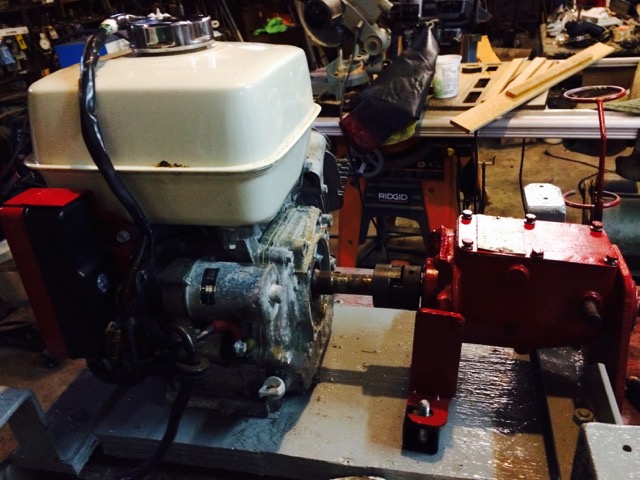
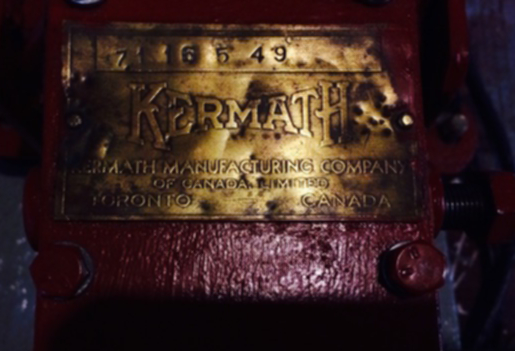
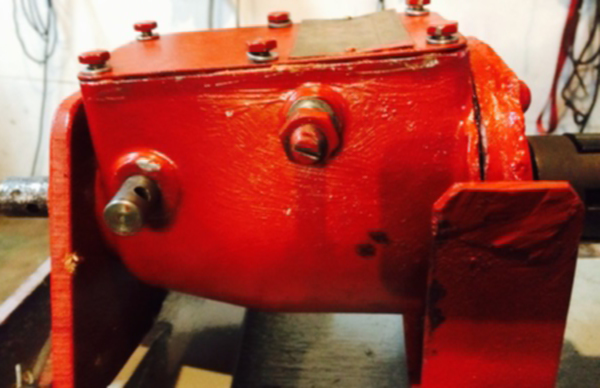
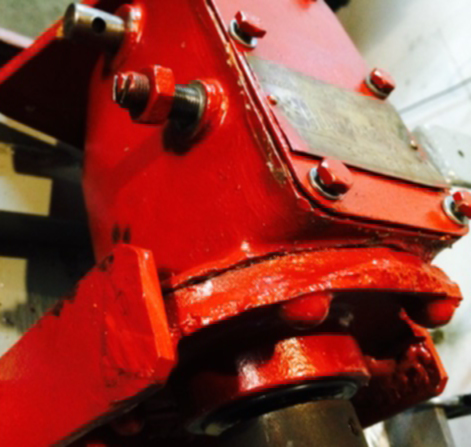
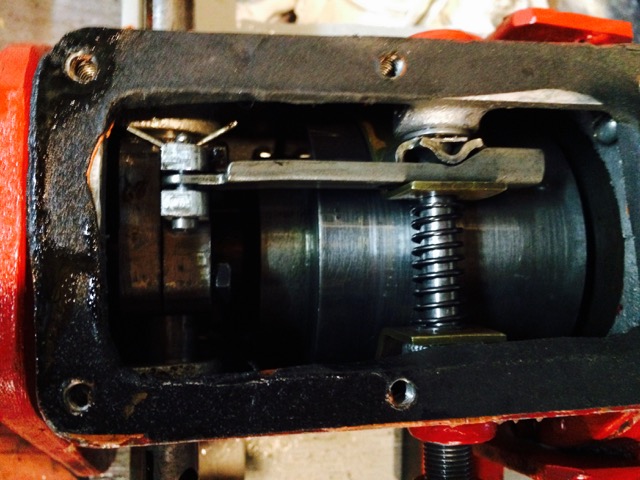
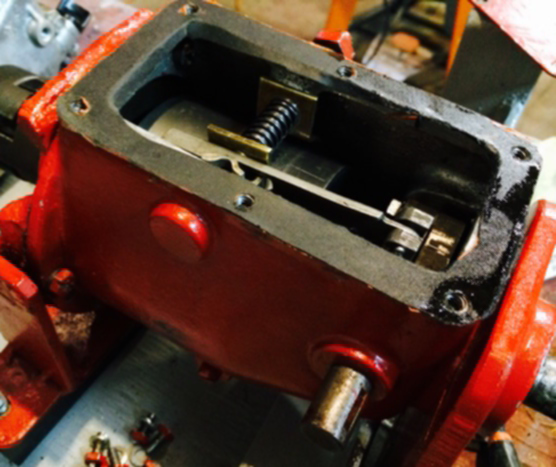 |
    
anthony gallagher
Visitor
| | Posted on Tuesday, November 17, 2015 - 02:55 pm: | 




|
Thanks again for posting the photos Bob. As to the cover plate info the only data is what you see. The serial #at the top has been no help except to guess that its vintage is perhaps 1949.No other data can be found anywhere. I don't know when Kermath Canada (toronto) was established and what if anything was actually made /sold there might provide some clues. At the end of the day though I am really most interested in locating some knowledge about how to set the clutch transmission up so it will stay in forward gear properly and have a proper neutral. So far getting reverse to function hasn't been accomplished except when reassembled outside of the housing. Anybody out there that is familiar with the process please weigh in. Thanks, Tony |
    
Robert B. Price
Senior Member
Username: rbprice
Post Number: 538
Registered: 11-2001

| | Posted on Tuesday, November 17, 2015 - 08:18 pm: | 




|
Tony - there is a good chance that Kermath did not manufacture the gearbox but purchased the mechanism from someone and put it into a casting designed to hold the parts and then put their own name on the nameplate.
For instance, the Red Wing Meteor Four in my tunnel boat has a Westerbeke L25 transmission in a housing that has Red Wing's name on it.
The second from the last picture shows a link rod with a detent and a spring to load the detent to keep it in place. Is that the mechanism that controls the Forward direction and does it seem to work properly?
I think that Westerbeke is still in business so if you can track them down and send them your pictures they just might be able to help. |
    
Ernie
Senior Member
Username: ernie
Post Number: 2175
Registered: 01-2002

| | Posted on Wednesday, November 18, 2015 - 10:17 am: | 




|
2 cents worth is that the engine is too big for the reverse gear.
The gear is Kermath from either a sea pup or sea twin. As noted above the forward end of the gear is actually part of the original engine crankcase. The little Kermath singles and twins were fairly low HP. The Honda is 13 HP at 3500 to 4000 RPM.
These little Kermath gears with conical clutches slip when they are worn or over leaded. If someone has tried to fix that then neutral is almost impossible to find.
Kermath sea twin 10 hp at 3,000
Kermath sea cub 5 hp
Westerbeke is still in business but this is not Westerbeke.
Hope this helps
Ernie |
    
Jim Thomson
Member
Username: brownboat
Post Number: 11
Registered: 02-2013
| | Posted on Wednesday, November 18, 2015 - 11:22 am: | 




|
I agree with Ernie, gear box appears to be from Sea Pup/Sea Twin. They use the same FNR gear box. Data plates for engine/gear box as a unit were put on the gear boxes. Contact me for copy of instruction booklet with section adjusting the reverse gear. Also have NOS gear box parts. As Ernie indicated the box is used on a 5 or 10 hp engine, bigger engine probably stresses the gear box too much. |


